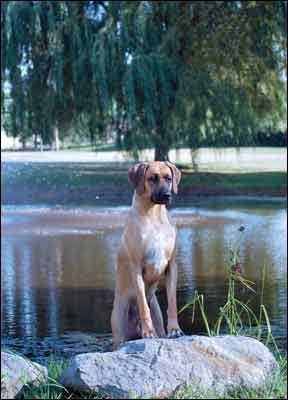[Updated July 19, 2017]
Holistic dog care . . . It sounds so trendy, so green, so Whole Foods. But it’s not as cut and dried as it sounds: You don’t just add bottled water and get Andrew Weil. Developing a holistic approach to your dog’s care is a process … a process of self-discovery on your part, leavened with lots of trial and error.

The real meaning of “holistic,” of course, is doing what’s right for your individual dog – and for you, taking into account your circumstances, lifestyle, budget, and beliefs. There is no template to follow, other than: Know your dog – and yourself.
Little more than a decade ago, inspired by a skinny, diarrhea-plagued puppy, I started exploring a new way of feeding my dogs. From there, I shifted my attitudes about vaccination, veterinary care, even training. It didn’t happen overnight: I made plenty of mistakes, and I continue to learn and grow and evolve my approach.
Here are 10 things I learned along the way. A lot of them are common sense, others may sound “woo-woo” if you’re not in a place where you’re receptive. And that’s okay, because the whole point of this journey we’re on is that your mileage can – and should – vary.
1. Get (Many) Tips from Successful Holistic Dog Handlers
I’m not going to compare feeding my first raw doggie meal to having to swallow centipedes on “Fear Factor,” but the undeniable truth is that many people feel trepidation on a Jungian scale when they begin to tinker with their dog’s diet. Many are anxious at just the thought of changing brands – “Will he get diarrhea? What I am I going to do with this $45 bag of food if he does?” – let alone feeding something as “out there” as raw meat. You visualize the microbes crawling all over the dish. You mentally plot your course to the nearest emergency clinic when . . . When what? When the ground opens and your beloved pooch is swallowed up, Hades-style?
The biggest antidote to that hollow-stomached, lung-squeezing sensation of not knowing if you are doing the right thing is finding people who have done it – successfully. In this, the Internet is a great place to find kindred spirits. They’ve been there, done that. Their experiences can reassure you. The biggest problem with turning to such people for comfort is that they’re so accustomed to doing what they’re doing that it’s now second nature – they don’t see it as any big deal. But it is a big deal to you, and having someone to talk to and compare notes with often makes the difference between plucking up your courage and blazing forward – or just abandoning ship and continuing with what hasn’t worked.
2. Don’t Worry About the What-Ifs
All this isn’t to say that any “holistic” course that you take – whether it’s raw feeding or minimal vaccination or “alternative” therapies, from Chinese medicine to chiropractic – is entirely safe. Everything comes with a degree of risk, including that bag of kibble, that syringe of attenuated live virus, that dose of prednisone.
We have no idea what tomorrow brings, and worrying about it is not only a waste of time, but – some would argue – only serves to roll out the welcome mat. I suppose when I walk down the street in Manhattan, a piano could fall on me. That doesn’t mean the risk of falling pianos outweighs the rewards of catching a Broadway show.
The doggie equivalent of 42nd Street is a walk in the woods. I know of dogs who have literally impaled themselves on sticks in their gorgeous frolicking abandon that is a wild race through a crunchy-leafed trail. This doesn’t mean that you never walk in the woods together, or that you do a stick sweep of the area. It just means you balance the risk with the reward of a gorgeous day out getting exercise and stimulation, and you decide accordingly. (And if your dog does impale herself, as counterintuitive as it sounds, don’t remove the stick. Just get her to a vet – any kind of vet.)
It’s easy to say, “Don’t get overwhelmed with the ‘what ifs'” – especially if, as luck would have it, a “what if” has actually happened to you before. But when making any important decisions in life, your mind has to be clear. And obsessing over what could go wrong – as opposed to weighing risks calmly and rationally – dooms you to failure before you even start. In order to successfully make a decision about your dog’s care, it has to feel good to you. Find a way to make that happen – which, for many, sounds easier than it actually is.
3. Pick 1 Holistic Dog Care Practice to Start
The great thing about complementary and alternative medicine is that there are so many options, so many different healing traditions available. That’s also the most frustrating thing: How do you know what route to choose? What’s the best way to treat your dog’s problem? Homepathy? Flower essences? Essential oils? Acupuncture? Kinesiology? I can’t even spell it, much less wrap my brain around it.
In this, research can take you only so far. If you’ve narrowed your search down to a few modalities that keep coming up over and over again, just pick one. Maybe you’ve heard about a local veterinarian who specializes in one particular modality. Maybe you have a friend who had great success using another. (See revelation #1.) Maybe – and I don’t diminish the power of this for one moment – one just “feels” right. Whatever your rationale, as those sneaker commercials exhort: Just do it.
Sometimes, of course, things don’t work out. When one of my dogs developed an ear hematoma, I researched how best to treat the growing, sausage-sized, blood-filled lump on his ear. I came across very few holistic options, and none of the conventional treatments – surgery to “quilt” the ear, cannula implants to drain the fluid – sounded appealing.
“Acupuncture!” I thought, and I made an appointment with a vet whose success with Chinese medicine I had long heard about. But during our consult, I was made to understand why acupuncture didn’t come up as an option for these annoying blood blisters of the ear: It doesn’t work on them. “Chinese medicine is not good for everything,” the vet shrugged. Lesson learned.

Blitz’s ear eventually did heal, as wizened and cauliflowered as any old prize fighter’s. But that visit was not a waste of time or money: It established a relationship between me and that vet, and taught me the limits of his modality. Today, 12-year-old Diva and I are regulars, and the vet’s herbal formulations are doing wonders for her degenerative disc disease. Trial and error – and all I ask is that I learn something from the error.
4. Keep a Dog Journal
In these Facebooking times, it seems that every meal we eat, every television show we watch, every speck of minutia in our daily lives is broadcast to the world. But you’re only as good as your last post or share, and sometimes, in the flood of all that information, and the relentless scroll of the News Feed, the most important thing is lost: continuity and context.
Holistic veterinarian Christina Chambreau has a great idea that too few owners follow: Keep a journal for each of your dogs. You don’t have to write in it religiously, but make a notation of things that may seem different or noteworthy: increased water consumption, changes in coat color or texture, seemingly minor health issues like a passing ear infection, sleeping later than usual, eating more ravenously, unusual discharge (from any of a number of places!), an odd odor (my son maintains that one of my Ridgebacks smells like pancakes, which may not be journal-worthy, but I still like hearing it).
Those little scraps of information – impressions, mostly – are fleeting and seemingly insignificant on a day-to-day basis, but taken as a whole they can illuminate patterns that can help in managing your dog’s health. For example, my dogs’ journals showed that bleeding ear tips – and by extension that annoying hematoma – happen mostly in winter. Turned out our toasty house was drying out the dogs’ skin, which made them more itchy, which made them shake more, which increased the likelihood they’d whack a flapjack ear on a table corner. The solution? A pan of water on the radiator in each room.
5. Prevention is the Best Medicine
Most alternative healing modalities believe that disease is a manifestation of deeper imbalances. Rather than treat the symptoms you must go deeper and bring things into equilibrium.
The easiest thing to do, of course, is to make sure that the imbalance doesn’t occur to begin with. That requires a strong, clean foundation: good food, good water, adequate exercise, mental stimulation, and a safe, toxin-free environment.
That last requirement was missing with a dog I bred. He was naturally reared, raw-fed, and minimally vaccinated, but since puppyhood, he was beset with all kinds of allergic reactions – red ear flaps, rashes on his undersides, puffy eye rims. He had every test under the sun, hypoallergenic diets, and nothing worked.
The dog lived in a rented house on a canal that had been flooded multiple times, and instinctively I thought: mold. When a new puppy arrived on the scene (from a different litter) she too started getting itchy and scratchy.
The family moved – far from the water this time – and at last report, the itchiness was receding. Good news not just for the dog, but his family as well: Dogs are our sentinels, and what unbalances their bodies and their health is a risk to ours, too.
6. Does the Vet Stay in the Picture?
In a perfect world, you and your vet would be one – cue babbling brook and clinking wind chimes – when it comes to your dog’s holistic care. If you have a relationship of respect and equality, any differences of opinion are more than surmountable.

But personality conflicts sometimes can create havoc with this relationship, all the more so if your conventional vet is unfamiliar with or suspicious of alternative modalities.
A common first reaction – especially if you encounter resistance – is to think about just leaving your vet, but sometimes you’re better off with the devil you know: There may not be a holistic vet nearby, and you may not click with him or her, either. Some holistic vets do not provide “nuts and bolts” holistic dog care, but rather operate more of a specialty-based practice. And remember that geography doesn’t have to be an issue: You can supplement your conventional vet’s knowledge with a phone consultation with a more holistic-minded practitioner.
I’ve found that a two-prong approach works best in having your dog treated holistically by a conventionally minded vet: You need to have respect and regard for your veterinarian’s expertise, and you need to become educated about the approach you are advocating.
Part of having respect for the veterinarian is making her aware of what treatments you are pursuing outside of her office – nobody likes surprises. And becoming educated about holistic medicine means acknowledging the risks as well as the advantages. If you want to follow a less aggressive vaccine protocol, for example, tell the vet up front that you are aware there is a risk of not vaccinating for X, but here is your rationale for why the pros do not outweigh the cons. Remember that vets are human, too, and direct experience often informs their reactions: Treating just one case of parvo can make a vet super-sensitive about vaccinating lightly against the disease; being blamed by clients when things go wrong is another reason for a reflexive reluctance to try new things.
To put it bluntly, often what you are up against is the combined stupidity of all your vets’ other clients, those who can’t or won’t follow directions, screw up even the most basic instructions, and are quick to blame everyone else when things don’t go just right. There aren’t enough people willing to do the research and go the extra mile to provide the kind of care you are advocating for your dog. When your vet realizes that, chances are you’ll see a change of attitude, too.
7. Do What You Can
It’s the height of irony that while a holistic approach is supposed to be about doing what’s best for the individual dog – and the human who is charged to care for him – that so much criticism can be leveled for not “doing it right.”
But holism isn’t an all-or-nothing approach: Even if you’re limited by what you can do, that doesn’t mean you do nothing at all. Feel good about what you can do; don’t focus on what you can’t do.
For example, I’d be lying if I said that I thought raw feeding wasn’t the best way to feed most dogs: It’s natural, bioavailable, and species-appropriate. I’ve seen a difference not only between dogs fed kibble and those that are raw fed, but also between dogs that have their food cooked as opposed to fed raw. Raw, in my experience, always comes out ahead, hands down.
But that doesn’t mean everyone is in a position to feed this way. Budget and supply come into play. Maybe there are infants or immune-compromised individuals in the household. Maybe someone just isn’t ready to take the leap.
Similarly, even if you are an ardent supporter of minimal vaccination, if you live in a microclimate where, say, lepto-spirosis is circulating, you might opt to protect your dog against that disease, despite the limitations of the vaccine, its relatively short duration, and concerns about its side effects.
Giving a lepto vaccine doesn’t invalidate your holism any more than feeding a high-quality kibble does. You do the best you can, with the resources you have, at the pinprick of time that you are living in. Don’t let anybody make you feel otherwise.
8. Avoid Extremes in Holism
Our animals, our bodies, our energy fields, crave balance, and that’s what we should strive for in caring for our dogs. On the one hand, be consistent: Give modalities a chance to work. Remember that problems take a while to brew and manifest, and so they can take a spell of time to resolve, too.

At the same time, don’t get stuck in a rut. Changing up every once in a while isn’t just a good idea, it’s a necessity. Rotating food sources, exercise patterns, and herbal supplements is important. As opportunistic omnivores, dogs are biologically programmed for variety. Their bodies crave it, and if we are to develop one habit, it is to remind ourselves in our busy lives to give it to them.
9. Fresh Air, Good Light, the Time and Room to Run Free…
Every time I am tempted to overthink or overdo things, I pick up a copy of Juliette de Bairacli Levy’s The Complete Herbal Handbook for the Dog and Cat, first published in 1955. Long before it became fashionable to feed locally or organically, de Bairacli Levy was there, sharing the wisdom she learned from the Gypsies, Berbers, and Bedouins.
In this day and age, when we expect precise directions and how-tos, her books can seem quaint. But there is powerful wisdom in them, reminders that the less interference we place between our animals and their source energy, the better off they are. De Bairacli Levy is one of the few authors who bothers to talk about the importance of sunshine in rearing healthy dogs. Fresh air, good light, the time and room to run free . . . I am reading The Secret Garden to my children at bedtime, and these are precisely the things that transformed the cranky, coddled twosome in the story, Mary and Colin, into healthy youngsters. They are as crucial as food in that regard. And sometimes we need pragmatists such as de Bairacli Levy to remind us of the basics.
“I pray you who own me, let me continue to live close to Nature,” de Bairacli Levy wrote on behalf of the dogs. “Know that: I love to run beneath the sun, the moon, and the stars; I need to feel the storm winds around me, and the touch of rain, hail, sleet, and snow; I need to splash in streams and brooks, and to swim in ponds, lakes, rivers, and seas; I need to be allowed to retain my kinship with Nature.”
It is no coincidence, I think, that de Bairacli Levy’s line of Turkuman Afghan Hounds was so sought-after, and no mere happenstance that the stock she sent to the United States went on to produce a dynasty of the world’s most beautiful and biggest-winning Afghan Hounds.
10. Believe in Intention
Here we are at number 10, the most diffuse and hardest to grasp of these lessons, because it’s one that you feel your way to.
Early on, a good friend of mine who I consider a wonderful healer told me, “Intention is important.” In other words, wanting to make your dog well is an important part of getting there. I thought that was kind of obvious: Who doesn’t want their dog to get better?
Then I learned more about vibrational medicine, about the power of thoughts and feelings, and about the law of attraction, which created a big buzz a few years ago but which was brought home more powerfully to me in the Abraham work of Esther and Jerry Hicks. (Google them if the names are unfamiliar: The premise behind their work is a little “out there” for many, but make like a buffet, take what you like, and leave the rest.)
Yes, you can want your dog to be well, but that intention can be so clouded and weighed down with worry about things not going right, with visions of worst-case scenarios, with fear and doubt, that it defeats the purpose.
My outcomes are always best when I envision what I want for my dog, let go of any underlying wanting that feels desperate or forced, and just proceed in the moment, not fast-forwarding to dissect any of the what-ifs.
The best way I can describe it is knowing how I want things to be, acknowledging that in the end I have no control over how they actually will be, but deciding that things will work out fine regardless. No more thinking beyond that, which is the tough part.
It’s sort of like watching a movie: I am invested in the outcome, know I want person A to fall for person B, but don’t micromanage my expectation of every scene. In the end, Spielberg never disappoints, anyway – even when the ending is not what I envisioned.
Denise Flaim of Revodana Ridgebacks in Long Island, New York, shares her home with three generations of Ridgebacks, three 8-year-olds, and a very patient husband.







Hi,
Do you know where I can post info on McNab Collie puppies, Free to good homes of people who are into intact dogs and holistic care? No re-homing charge. Excellent pedigree. Excellent temperament, High energy, like Border Collies but calmer. Available for re-homing after April 20th. Pups are in CA. Transportation available.
Thank you.